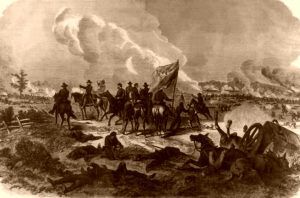Battles (By Date):
Fort Pulaski (April 10-11, 1862) – Fort Pulaski, built by the U.S. Army before the war, is located near the mouth of the Savannah River, blocking upriver access to Savannah, Georgia. Fortifications such as Pulaski, called third-system forts, were considered invincible, but the new technology of rifled artillery changed that. On February 19, 1862, Union Brigadier General Thomas W. Sherman ordered Captain Quincy A. Gillmore, an engineer officer, to take charge of the investment force, begin the bombardment, and capture the fort. Gillmore emplaced artillery on the mainland southeast of the fort and began the bombardment on April 10, 1862, after Confederate Colonel Charles H. Olmstead refused to surrender the fort. Within hours, Gillmore’s rifled artillery had breached the southeast scarp of the fort, and he continued to exploit it. Some of his shells began to damage the traverse shielding the magazine in the northwest bastion. Realizing that if the magazine exploded, the fort would be seriously damaged and the garrison would suffer severe casualties, Olmstead surrendered after 2:00 p.m. on April 11, 1862. The Union Victory resulted in one Union casualty and 364 Confederates.
Fort McAllister I (March 3, 1863) – Taking place in Bryan County, this naval attack on Fort McAllister occurred when Union Rear Admiral Samuel F. Du Pont ordered three ironclads, Patapsco, Passaic, and Nahant, to test their guns and mechanical appliances and practice artillery firing by attacking Fort McAllister, then a small three-gun earthwork battery.
On March 3, 1863, the three Ironclads conducted an eight-hour bombardment. The bombardment did not destroy the battery but did some damage, while the three ironclads received some scratches and dents. The tests were helpful for knowledge and experience gained, but the fort did not fall, showing that the Ironclads’ firepower could not destroy an earthen fort. The Confederate victory resulted in an unknown number of casualties.
Davis’ Cross Roads (September 10-11, 1863) – Also called the Battle of Dug Gap, this skirmish, part of the Chickamauga Campaign, occurred in Dade and Walker Counties. After the Tullahoma Campaign, Union General William S. Rosecrans renewed his offensive to force the Rebels out of Chattanooga, Tennessee. The three corps comprising Rosecrans’ army split and set out for Chattanooga by separate routes.
Hearing of the Union advance, Confederate General Braxton Bragg concentrated troops around Chattanooga. While Colonel John T. Wilder’s artillery fired on Chattanooga, Rosecrans attempted to take advantage of Bragg’s situation and ordered other troops into Georgia. They raced forward, seized the important gaps, and moved into McLemore’s Cove.
Union Major General James Negley’s XIV Army Corps division, supported by Brigadier General Absalom Baird’s division, was moving across the mouth of the cove on the Dug Gap road when Negley learned that Rebels were concentrating around Dug Gap. Moving through determined resistance, he closed on the gap, withdrawing to Davis’ Cross Roads on the evening of September 10 to await the supporting division.
Bragg had ordered Major General Thomas C. Hindman with his division to assault Negley at Davis’ Cross Roads in the flank, while Major General Patrick R. Cleburne’s division forced its way through Dug Gap to strike Negley in front. Hindman was to receive reinforcements for this movement, but most of them did not arrive. Therefore, The Rebel officers met and decided they could not attack in their present condition.
The following day, however, fresh troops did arrive, and the Rebels began to move on the Union line. By now, the supporting Union division had joined Negley, and, hearing of a Confederate attack, the Union forces determined that a strategic withdrawal to Stevens Gap was in order. Negley first moved his division to the ridge east of West Chickamauga Creek, where it established a defensive line. The other division then moved through them to Stevens Gap and established a defensive line there. Both divisions awaited the rest of Major General George Thomas’s corps. All of this was accomplished under constant pursuit and fire from the Confederates. The number of casualties in the Union strategic victory is unknown.
Chickamauga (September 18-20, 1863) – Taking place in Catoosa and Walker Counties, this considerable battle occurred after the Tullahoma Campaign, when Major General William S. Rosecrans renewed his offensive, aiming to force the Confederates out of Chattanooga, Tennessee. The three army corps comprising Rosecrans’ army split and set out for Chattanooga by separate routes. In early September 1863, Rosecrans consolidated his forces in Tennessee and Georgia, forcing Confederate General Braxton Bragg’s army out of Chattanooga, heading south. The Union troops followed them and brushed and skirmished at Davis’ Cross Roads. Bragg was determined to reoccupy Chattanooga, met a part of Rosecrans’ army, defeated them, and then moved back into the city. On September 17, he headed north, intending to meet and beat the XXI Army Corps. As Confederate General Bragg marched north on the 18th, his cavalry and infantry fought with Union cavalry and mounted infantry armed with Spencer repeating rifles. Fighting began in earnest on the morning of the 19th, and Bragg’s men hammered but did not break the Union line.
The next day, Bragg continued his assault on the Union line on the left, and in the late morning, Rosecrans was informed that he had a gap in his line. In moving units to shore up the supposed gap, Rosencrans created one. Confederate General James Longstreet’s men promptly exploited it, driving one-third of the Union army, including Rosecrans himself, from the field. Union General George H. Thomas took over command and began consolidating forces on Horseshoe Ridge and Snodgrass Hill. Although the Rebels launched determined assaults on these forces, they held until after dark. Thomas led these men from the field, leaving it to the Confederates. The Union retired to Chattanooga while the Rebels occupied the surrounding heights. The Confederate victory resulted in 34,624 total casualties — Union, 16,170 and Confederate, 18,454.
Ringgold Gap (November 27, 1863) – Part of the 1863 Chattanooga-Ringgold Campaign, this conflict occurred in Catoosa County. Following the Union victory at Missionary Ridge, Tennessee, on November 25, 1863, and the Rebel retreat, Yankee troops set out in pursuit. Confederate Major General Patrick Cleburne’s command fell back to Ringgold Gap, where the Western & Atlantic Railroad passed through Taylor’s Ridge. Union Major General Joseph B. Hooker sent his force forward to seize the ridge, which it failed to do after five hours of heavy fighting. The Confederate victory resulted in estimated casualties of 432 Union and 480 Confederate.
Dalton I (February 22-27, 1864) – From Vicksburg, Mississippi, Union General William T. Sherman launched a campaign to take the vital railroad center at Meridian and, if the situation was favorable, to push on to Selma and threaten Mobile, Alabama to prevent the shipment of Confederate men and supplies. Confederate President Jefferson Davis ordered troops into the area to counter the threat. While these operations unfolded, Union Major General George H. Thomas determined to probe Confederate General Joseph E. Johnston’s army in the hope that Johnston’s loss of two divisions, sent to reinforce Lieutenant General Leonidas Polk as he withdrew from Meridian to Demopolis, Alabama, would make him vulnerable. Skirmishing and intense fighting occurred throughout the demonstration. At Crow Valley on February 25, Union troops almost turned the Rebel right flank, but it ultimately held. On February 27, Thomas’s army withdrew, realizing that Johnston was ready and able to counter any assault. The number of casualties suffered in the Confederate victory is unknown.


